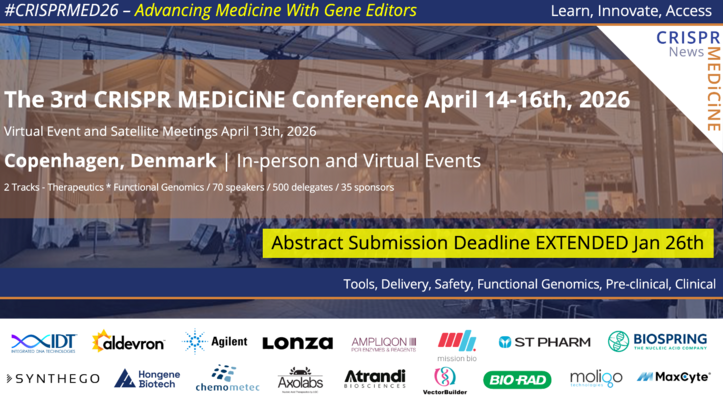CMN Weekly (9 August 2024) - Your Weekly CRISPR Medicine News
CMN Intelligence - The World’s Most Comprehensive Intelligence Platform for CRISPR-Genomic Medicine and Gene-Editing Clinical Development
Providing market intelligence, data infrastructure, analytics, and reporting services for the global gene-editing sector. Read more...
Top picks
- CRISPR has revolutionised the field of genome engineering, but its use in educational settings is limited by high resource requirements. To address this, a group of researchers have developed CRISPRkit, an affordable and accessible kit designed to bring hands-on CRISPR gene editing and regulation into high school education. The kit, described in a publication in Nature Communications earlier this week, eliminates the need for specialised lab equipment by using cost-effective reagents, smartphone-based quantification, and a custom algorithm, allowing students to perform and analyse CRISPR experiments directly in the classroom. By enabling experiments like controlling fluorescent proteins and metabolic pathways, CRISPRkit aims to make biotechnology education more equitable and accessible to diverse communities, and to greater the next generation of genome engineers.
- Breaking the Chains: How CRISPR Gene Therapy Gave Victoria Gray a New Life: An article published in Biopharma last week details the story of Victoria Gray, one of the first CASGEVY™ receivers who was enrolled in the clinical trial study for sickle cell disease. The article describes how Victoria’s life was dramatically changed by the first ever approved CRISPR-based gene therapy. Read more about CASGEVY™ here, in our article published earlier this year.
- Vertex Pharmaceuticals have announced a significant agreement with the NHS England to provide access to CASGEVY™, the groundbreaking gene-editing therapy, for eligible patients with transfusion-dependent beta thalassemia (TDT). This follows the U.K.'s Medicines and Healthcare products Regulatory Agency (MHRA) granting CASGEVY™ the world's first approval for a CRISPR-based therapy in November last year. CASGEVY™ offers a potential one-time treatment option that could drastically improve the lives of TDT patients, who otherwise face lifelong blood transfusions and related complications. Vertex is also working to expand access to this therapy for sickle cell disease patients in England and other regions. Read more about this milestone from the BBC here.
We are thrilled to have announced last week that Jimi Olaghere, a CASGEVY™ recipient who participated in CRISPR Therapeutics' and Vertex Pharmaceuticals' groundbreaking clinical trial, will share his story at CRISPRMED25 - the 2nd CRISPR Medicine Conference in Copenhagen, April 8-11, 2025. Read more about that here.
Research
- In an article published this week by Disease Models and Mechanisms, a group of researchers in Toronto describe a CRISPR-Cas9 generated novel mouse model for becker muscular dystrophy (BMD), a neuromuscular disorder for which new therapies are urgently required. This novel mouse model harbours typical BMD-like in-frame deletion of exons 52 to 55, a BMD mutational hotspots not previously represented in animal models. This study hopes to provide a comparison between different models of BMD in order to gain insights on the functionality of different dystrophin isoforms, and by doing so address the growing requirement for new BMD treatment options.
- Researchers from China have developed a RNF5 knockout mouse model using CRISPR-Cas technology to investigate Myocardial infarction (MI), commonly known as a heart attack. In an article published this week in BMC Cardiovascular Disorders, the group found that RNF5 was downregulated in infarcted mouse hearts, with RNF5 knockout exacerbating heart dysfunction, inflammation, and apoptosis after MI. The study suggests that RNF5 plays a protective role in MI by negatively regulating the ASK1 signalling pathway, pointing to potential new therapeutic strategies for MI.
- An article published in Cancer Cell International describes a study by a group of researchers in China to investigate upstream promoter methylation of the oncogene TERT as a therapeutic target for thyroid cancer. The group investigated the effects of upstream promoter methylation in regulating TERT expression in thyroid cancer cells lacking TERT promoter mutations. They used CRISPR-based genomic locus-specific demethylation (dCas9-TET1) and demethylating agents to alter DNA methylation, revealing that demethylation reduced TERT expression, inhibited cell growth, and induced apoptosis. This study aids to uncover the mechanism of TERT activation by promoter methylation in thyroid cancer cells harbouring no TERT promoter mutations and indicates TERT upstream promoter methylation as a therapeutic target for thyroid cancer.
- RNA therapies have shown recent success, providing safe and efficient targets for gene knockdown in clinical application. RNA base editing now promises to expand the scope of RNA therapeutics. A recent publication in Nature Communications describes the use of RNA base editing to manipulate protein function by removing regulatory phosphorylation and acetylation sites. The researchers in this study applied an improved version of SNAP-ADAR, an engineered RNA base editing tool. This approach was successfully demonstrated on over 70 sites in various signalling proteins, showing potential for both positive and negative regulation, particularly in the JAK/STAT pathway. The method offers advantages such as high efficiency, fast and reversible effects, and dose-dependent control, making it a promising tool for precise protein regulation compared to DNA editing. Post-translational modification interference could become a significant application of RNA base editing with implications in the development of novel genome-editing therapeutics.
- A group of researchers from China describe the use of a novel CRISPR-associated technology to perform prime editing of Vascular Endothelial Growth Factor Receptor 2 (VEGFR2). The study, published by The CRISPR Journal, focuses on the development of a new prime editing system called PE6h, which is designed to precisely edit genes involved in angiogenesis, like VEGFR2, a key player in angiogenesis, which is observed in various human diseases. PE6h uses two lentiviral vectors: one with a modified CRISPR-Cas9 protein and enhanced guide RNA, and the other with a dominant negative MutL homolog 1 gene with nicking guide RNAthat helps target the editing process. By using PE6h to introduce a premature stop codon in VEGFR2 in human retinal cells, researchers were able to produce a dysfunctional form of VEGFR2 that blocked important signalling pathways and inhibited angiogenesis. This demonstrates the potential of PE6h as a tool to prevent disease related angiogenesis.
- A group of researchers from Korea published an article in Science Translational Medicine this week describing the engineering of a novel exosome-based delivery system called MAPLEX, where cargo proteins can be loaded into the exosomes by fusion with the photocleavable protein mMaple3, which is then fused to an exosomal marker protein. The delivery system seeks to overcome limitations set by the inability of protein-based therapeutics to cross cell membranes, restricting successful treatment of many diseases. The system was successfully used to achieve targeted epigenome editing in the brains of two models of Alzheimer’s disease. The study provides evidence that MAPLEX could be an efficient intracellular protein delivery system holding promise for multiple diseases that could potentially be mitigated with protein-based therapeutics.
Industry
- Fierce Biotech have announced their 2024 Fierce 15, highlighting 15 of the most promising and innovative biotechnology companies. The list includes several gene editing companies including Ascidian Therapeutics, Excision BioTherapeutics, and iECURE. Read the 2024 Fierce 15 here.
- Sangamo Therapeutics has entered into a licensing agreement with Genentech to develop genomic medicines for neurodegenerative diseases, focusing on Sangamo's zinc finger repressors targeting the tau gene, linked to Alzheimer’s, and a second undisclosed target. The agreement, detailed in a press release, includes the exclusive licence of Sangamo’s STAC-BBB, a neurotropic AAV capsid with strong brain penetration capabilities. Sangamo will receive $50 million upfront, with potential earnings of up to $1.9 billion in milestones and tiered royalties, while continuing to explore further partnerships for its genomic technologies.
- Beam Therapeutics have reported pipeline updates and second quarter 2024 financial results. The company reported significant progress in its clinical programs using base editing technology, including the successful enrollment and dosing of patients in the BEACON trial for sickle cell disease, and the initiation of trials for genetic diseases such as alpha-1 antitrypsin deficiency and glycogen storage disease type Ia.
- 2seventy bio reported its second quarter 2024 financial results and recent operational progress in a press release published this week. Included in the report are plans to focus progression with ABECMA®, a CAR-T cell therapy used to treat certain types of haematological malignancies, specifically relapsed or refractory multiple myeloma.
- CRISPR Therapeutics provided its second quarter 2024 financial results and business updates in a press release earlier this week. Included in the report are progress updates for the first approved CRISPR-based gene therapy, CASGEVY™ , as well as several other ongoing clinical trials currently underway in the company's pipeline.
- Caribou Biosciences announced business updates and its second quarter 2024 financial results in a press release earlier this week. Included in the report is details on the company’s advancing of four clinical-stage programs for haematological malignancies and autoimmune diseases, with data reports expected in 2024 and early 2025, while enrolling patients for further trials based on recent CB-010 Phase 1 data, and has $311.8 million in funding, extending its cash runway into the second half of 2026.
- Cellectis has provided a financial report for the second quarter 2024, including updates on the UCART22 and CLLS25 trials for the treatment of acute lymphoblastic leukaemia. Read about the report here.
- Editas Medicine has announced second quarter 2024 financial results and business updates including updates on the RUBY and EdiTHAL trials and more. Read more about the report in the press release.
- Intellia Therapeutics announces second quarter 2024 financial results and reports on overall company progress. The report includes updates on the phase 2 study of NTLA-2002 for hereditary angioedema (HAE), the phase 3 MAGNITUDE trial of NTLA-2001 for transthyretin (ATTR) amyloidosis, and more. Read the announcement here.
- Prime Medicine reports its second quarter 2024 financial results in a press release earlier this week. The press release provides the company's recent business updates.
- Allogene Therapeutics have reported its second quarter 2024 financial results and business updates in a press release, including updates to the ALPHA3 clinical trial, and more.
- ProQR has reported its second quarter 2024 financial results and business updates, including updates to the AX-0810 and AX-1412 clinical trials. Read the financial report here.
- Poseida Therapeutics announces second quarter 2024 financial results and reports on overall company progress. Read the report in the press release here.
CRISPR screens
- A group of researchers published an article in HemaSphere this week describing a novel CRISPR-Cas9-mediated reporter cell line to evaluate endogenous foetal haemoglobin induction and screen for therapeutic compounds. The novel assay aims to identify inducers of foetal haemoglobin (HbF) by leveraging a reporter cell line which is the first to allow for successful tagging of the endogenous foetal globin genes HBG1 or HBG2. The new assay is based on HUDEP2 cells, which closely resemble adult human erythroid progenitors and do not upregulate HbF under stress, unlike primary erythroid cells. The study uses CRISPR-Cas9-mediated knock-in to integrate a bioluminescent tag at the HBG1 gene and successfully showed that the resulting reporter cell line mirrors the HUDEP2 characteristics, allowing for reporting of foetal haemoglobin induction with high sensitivity and specificity. This new tool represents a significant advancement over previous systems by providing a more specific and sensitive method to identify potential therapeutic inducers of HbF.
- An article published in Acta Neuropathologica Communications this week details a study that used genome-wide CRISPR-Cas9 knockout screens in murine SMB21 and human DAOY cells to identify alternative therapeutic targets for Sonic hedgehog subgroup of medulloblastoma (SHH-MB). While Smoothened (SMO) inhibitors have shown promise in treating such medulloblastomas, drug-resistance remains an on-going challenge. To address this, researchers used CRISPR-Cas9 screening to investigate genetic dependencies and drug-related genetic interactors, identifying DNA methyltransferase 1 (DNMT1) as a key epigenetic target. Inhibiting DNMT1, alone or with SMO inhibitors, significantly reduced tumour growth and extended survival in SHH-MB models. This study provides evidence for the considerable uses of CRISPR-Cas9 knock-out screens in drug development.
Reviews
- Gene therapy clinical trials worldwide to 2023—an update: A review published in The Journal of Gene Medicine this week presents a detailed analysis of all clinical trials, completed and ongoing regarding gene therapies. The review includes geographical distributions of 3,900 clinical trials, as well as disease indications for trials, delivery methods used, and which genes have been targeted. The review offers an insight into the universal progress of gene therapies, as well as notable key trends in the field.
- Next-generation CRISPR-based gene-editing therapies tested in clinical trials: A recent review published in Nature Medicine provides an in depth overview of the rapid evolution of gene-editing therapies, highlighting the FDA's approval of CASGEVY™ and the future of gene-editing therapies. Despite this breakthrough, challenges remain, including the limitations of ex vivo editing, the high cost of treatment, and the need for more precise and safer gene-editing tools. This review provides a summary of the emergence of base editing and prime editing which offer promising alternatives by enabling more precise genetic modifications without cutting DNA, potentially broadening the scope of treatable conditions and making gene-editing therapies more accessible and safer. The article emphasises the importance of continued innovation, collaboration, and regulatory adaptation to advance the field of gene-editing and enhance patient care.
- Beyond CAR-T: The rise of CAR-NK cell therapy in asthma immunotherapy: A recent review published in the Journal of Translational Medicine provides a summary of the evolution of CAR therapies and on-going pre-clinical and clinical studies involving CAR-based therapies for asthma. Asthma remains a significant public health challenge, particularly for patients resistant to existing treatments. The review provides a detailed comparative analysis of CAR-T and CAR-NK cell therapy, including their respective challenges. While CAR-T cell therapy has shown promise in cancer treatment, researchers are now exploring CAR-NK cell therapies for asthma due to its advantages, such as broader patient compatibility, fewer side effects, and scalability. Various strategies, including the use of AI for CAR design and CRISPR-Cas9 for gene editing, are being investigated to optimise these therapies. This review examines the development, effectiveness, and potential of CAR-NK cell therapy for asthma, highlighting both its promise and the challenges ahead.
- Harnessing the power of CRISPR based microfluidics for next-generation molecular diagnostics: This review discusses the integration of CRISPR-based technologies with microfluidic platforms to enhance molecular diagnostics. While CRISPR offers high precision, applications remain limited by high costs, technical demands, and difficulties in quantification. Microfluidics harbour the ability to miniaturise and automate processes, addressing these challenges by making diagnostics more sensitive, portable, and accessible. The review discusses various CRISPR-Cas systems, their use in detecting DNA and RNA biomarkers, and more.
- Precision Genetic Therapies: Balancing Risk and Benefit in Patients with Heart Failure: This review discusses recent developments and new approaches in gene therapy for cardiomyopathy and heart failure.
News from CRISPR Medicine News
- Plans for the CRISPRMED25 conference on April 8-11th, 2025 are well and truly underway, with several exciting speakers already confirmed. We are delighted to announce early-bird registration is now open. Read more and sign up for the conference on the conference official website here.
Billie Pang is a genomics scientist and science writer/communicator based in Dublin, Ireland.
To get more CRISPR Medicine News delivered to your inbox, sign up to the free weekly CMN Newsletter here.
Tags
ArticleMissing linksNewsCMN Weekly2seventybioAllogene Therapeutics, Inc.Ascidian TherapeuticsBeam Therapeutics Inc.Caribou Biosciences, Inc.Cellectis S.A.CRISPR Therapeutics AGEditas Medicine, Inc.Excision BioTherapeuticsiECUREIntellia Therapeutics, Inc.Poseida TherapeuticsPrime MedicineProQR TherapeuticsSangamo Therapeutics Inc.Vertex Pharmaceuticals, Inc.
CLINICAL TRIALS
Sponsors:
Base Therapeutics (Shanghai) Co., Ltd.
Sponsors:
Base Therapeutics (Shanghai) Co., Ltd.







